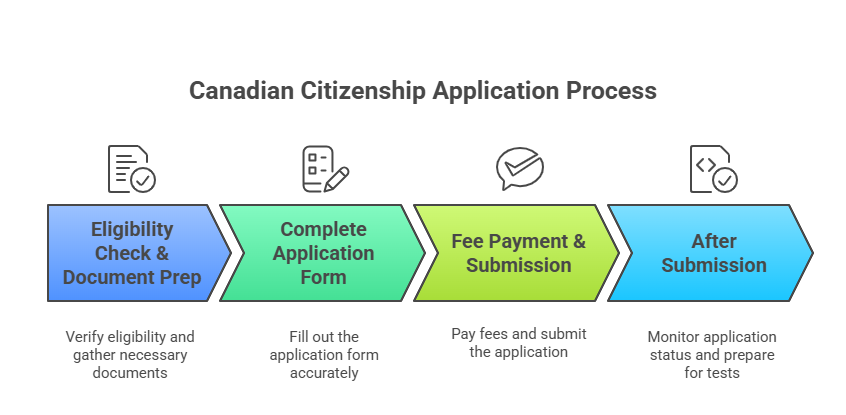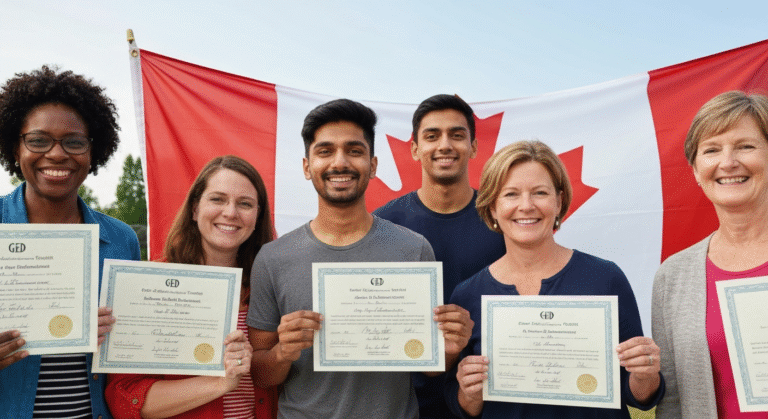Key Highlights of Canadian Citizen After PR
- To apply for Canadian citizen as a permanent resident, you must meet specific eligibility requirements, including a physical presence of at least 1,095 days within the last five years.
- Your citizenship application involves completing a formal application form and paying the applicable fees to the Canadian government.
- Successful applicants will take a citizenship test that assesses their knowledge of Canada’s history, values, and government.
- Upon approval, applicants are invited to a citizenship ceremony where they officially become Canadian citizens.
- Common challenges in the process include maintaining physical presence records and ensuring all documents are accurately prepared.
- Understanding the benefits of Canadian citizenship, such as the right to vote and access to a Canadian passport, is vital for applicants.
Introduction
The journey to canadian citizenship after PR is a big step for many who want to be a canadian citizen. When you know the details of the application process, you can feel sure about what to do next. Getting canadian citizenship is not only a legal status, but it also helps people feel that they belong.
This guide will show you the eligibility criteria for becoming a canadian citizen. It will explain the application process, and tell you about the benefits you get with canadian citizenship. You will get all the info needed so you are ready to move forward in the right way.
Canadian Citizen After PR
Becoming a Canadian citizen after you get permanent resident status needs you to follow some main steps. You must meet the days of physical presence requirement and show your language skills. To do this, you have to keep your permanent resident status and spend at least 1,095 days in Canada within the last five years. The IRCC citizenship application will ask for proof of your language proficiency and you will need to take the Canadian citizenship test.
Once you finish these steps and get your Canadian citizenship, you will get many good things. You can apply for a Canadian passport and you can take part in municipal elections.
Eligibility Requirements Checklist
Meeting the eligibility criteria is important for becoming a Canadian citizen after being a permanent resident. You need to show you have a physical presence in Canada for at least 1,095 days in the past five years. You must also keep a valid PR status and make sure there are no unfulfilled conditions on it. Applicants from age 18 to 54 must give proof of language proficiency with Canadian Language Benchmarks, or CLB. You will also need to show income tax filing for three out of the last five years to follow Canadian laws.
Physical Presence in Canada(1,095 days in 5 years)
- To qualify for Canadian citizenship, you must be physically present in Canada for at least 1,095 days within the last five years, including time as a permanent resident or protected person.
- Use a physical presence calculator and keep detailed records of travel and residence to ensure you meet this IRCC eligibility requirement; missing days can cause issues with your application.
- Only full days in Canada count, and time spent abroad doesn’t; meeting this requirement means you can confidently move forward from PR to citizenship.
PR Status Requirements
Maintaining your permanent resident (PR) status is essential for becoming a Canadian citizen. A valid PR card proves you meet residency requirements and comply with Canadian laws. Make sure your PR status does not expire and that you have no unfulfilled conditions that could jeopardize your application. Regularly check and follow rules set by IRCC, as these can change and directly impact your eligibility. Staying informed and keeping your PR in good standing are crucial steps toward citizenship and eventually obtaining a Canadian passport. Your journey to citizenship after PR relies on meeting all requirements and maintaining your PR status.
Tax Filing (3 of 5 years)
Showing that you follow tax rules is very important when you apply for Canadian citizenship. You must file your income tax as a resident in Canada. This needs to be done for at least three out of the five years before you apply. It does not matter how much you earn. The main thing is that you follow the rules and help with the country’s economy. Making sure your taxes are in order will help you meet the eligibility requirements for Canadian citizenship. It also shows that you are ready to do your part as a member of Canadian society and take on its duties.
Language & Age Rules
To become a Canadian citizen, it is important be fluent in either English Language or French. If you apply for canadian citizenship, you need to show your language skills with the right proof. You can use test results or records from your school. The language proficiency rule is for people who be 18 to 54 years old. These eligibility criteria show that speaking english or french means a lot in Canada. So, you can fit in better with other people, and you will have a good experience as a new canadian citizen.
Step-by-Step Canadian Citizenship Application Process

Finishing a citizenship application involves several key steps. First, review the eligibility criteria for Canadian citizenship. Next, gather essential documents, such as proof of PR status and language proficiency. Ensure that all your information is accurate, and complete the citizenship application from the IRCC. Afterward, pay the required fees and await further processing. Once submitted, monitor your application status and prepare for the citizenship test and interview. These steps comprise a significant part of your journey toward becoming a Canadian citizen.
Step 1 — Eligibility Check & Document Prep
Eligibility verification is the first and necessary step to get Canadian citizenship. You should start by checking if you meet Canadian citizenship requirements. Make sure you keep your permanent resident status. You also need to be in Canada for 1,095 days over the last five years. This is called the physical presence requirement.
Get all the needed documents ready. These can be proof that you live in Canada, papers to show language proficiency, and records of your tax filings. The IRCC citizenship application guides have helpful checklists. These can make the process easier for you to follow. This way, you can begin your citizenship application with confidence and know you are ready.
Step 2 — Complete Application Form
Filling out the citizenship application form is an important part of becoming a Canadian citizen. Start by carefully filling in the IRCC citizenship application. Make sure every required field is filled. Double-check all your details to see that they are correct. If something does not match, it could slow down the process.
Add every needed document. Some papers you might need are proof of language proficiency and your tax records. Be sure to sign and date the form before you send it. When you do this, you show that all information is true and complete. Paying attention to these steps will make your Canadian citizenship journey better and smoother.
Step 3 — Fee Payment & Submission
Finishing the fee payment and form submission is an important step for your Canadian citizenship application. You have to use the correct way to pay, like a credit card or a bank draft, which is listed by the IRCC. After you pay the right of citizenship fee, check that you have all the right papers ready. You can send your canadian citizenship application online or by mail, but you must follow the set rules. Doing this is key if you want to keep your permanent resident status and move forward to become a canadian citizen. This makes sure your citizenship application goes the right way and helps you on your way to becoming a part of canada.
Step 4 — After Submission
After you turn in your application, you will get a message from IRCC that they have received it. This message is important, as it starts the process for your Canadian citizenship. Some people might be asked to give more information, send extra papers, or go for an interview. It is important for you to keep up with all updates about your Canadian citizenship test and other next steps. This way, you will be ready for whatever they ask you to do.
Processing Times & Realistic Timeline 2025
Processing times for canadian citizenship applications change based on your situation and how busy IRCC is. Most people get a decision between 12 months and 24 months. Some things can make these times longer or shorter. For example, if your paperwork is not complete, if they need to check your background, or if the process slows down for some reason.
If you want to go from PR to become a canadian citizen in 2025, be sure to remember these things. Know what is normal now and pay attention to problems that could hold things up. This can help you set your plans and be ready for anything that happens as you work to be a canadian citizen.
Current IRCC Processing Standards
Processing times at IRCC depend on your application type and how many people are applying. For canadian citizenship, it usually takes between 12 and 24 months from when you send your application in. The processing time can be longer if your application is missing information or if IRCC asks you for more documents. Sometimes you may need to go for an interview, and that can also affect the timeline. You can check your application status online to get updates. That helps you know what is happening with your canadian citizenship application as you move from PR to being a citizen in Canada.
Common Delays & Bottlenecks
Many things can slow down or block the canadian citizenship application process. For one, missing paperwork is a big problem. If there is no proof of physical presence or language proficiency, the citizenship application can take much longer to finish. Also, if a permanent resident has issues, like an expired PR card or unfulfilled conditions, that can make the application process harder. Fluctuations in how long IRCC takes to handle requests can add more wait time. So, people applying for canadian citizenship often find that they have to wait longer than they thought for their papers to be ready.
Timeline Table
| Stage | Timeline |
|---|---|
| Application Preparation | 1-3 months |
| IRCC Processing Time | 12 months on average |
| Citizenship Test | 3-6 months post-application |
| Oath of Citizenship Ceremony | 4-6 months after the test |
| Canadian Citizenship Certificate | Received within weeks thereafter |
| Canadian Passport after PR | Apply immediately post-citizenship |
Ensure to allow for potential delays due to factors like application volume and accuracy. Always consult IRCC for the most current updates.
Citizenship Test & Interview Guide
Preparing for the Canadian citizenship test and interview is a significant step after becoming a permanent resident. The test assesses your knowledge of Canada’s history, values, and rights necessary for citizenship. It typically includes multiple-choice questions and may have oral components, helping to ease anxiety.
During the interview, a citizenship official reviews your application, ensuring you meet language requirements and confirm your physical presence in Canada. Being well-prepared boosts your confidence and enhances your chances of success in obtaining citizenship.
Test Preparation
Getting ready for the Canadian citizenship test is important. Here are key steps to help you prepare:
- Review the official study guide to learn about Canada’s history, values, institutions, and rights. This will help you understand the citizenship test requirements and boost your confidence.
- Join study groups or participate in online forums to connect with others, share tips, and find useful resources for test preparation. Practice tests are helpful to identify areas you need to improve.
- Make sure you meet the required language proficiency level, as language skills are crucial for the citizenship test and the overall process of becoming a Canadian citizen.
Test Format & Scoring
The Canadian citizenship test is a multiple-choice exam with 20 questions based on the official study guide. You must answer at least 15 questions correctly to pass. The test covers Canada’s history, rights, and responsibilities, and all questions have equal value. You can take the test in English or French. If you pass, you’ll proceed to an interview, which is the next step toward citizenship after PR.
- Test Highlights: 20 multiple-choice questions, pass mark is 15 correct answers.
- Next Step: Passing leads to an interview, bringing you closer to citizenship.
Interview Tips
Getting ready for your Canadian citizenship interview is easier with preparation. Review common questions about Canada’s history and government, and reflect on your reasons for seeking citizenship. At the interview, you must prove you meet the physical presence rule and bring all required documents, such as proof of language skills and tax records. Staying calm and friendly helps make a good impression.
- Double-check you have all needed documents before your appointment, as officials will likely ask for them.
- The more prepared and confident you are, the smoother your interview will go.
Benefits of Canadian Citizenship
Enjoying the perks of Canadian citizenship has many benefits. Key advantages include:
- The right to apply for a Canadian passport, allowing global travel and access to consular assistance.
- Eligibility for various social services, including affordable healthcare and education, as well as the opportunity to participate in municipal elections, empowering citizens to contribute to their communities.
Additionally, Canadian citizens have improved job prospects, including access to federal positions that reflect their commitment and involvement as active members of society.
Common Problems & Solutions
There can be challenges when transitioning from permanent residency to Canadian citizenship. Many applicants struggle to meet the physical presence requirements, which can hinder their application. A physical presence calculator can help track necessary days. Additionally, document errors may complicate the process, making it crucial for all paperwork to align with Canadian citizenship requirements. Issues related to criminal records or inadmissibility can also cause delays. Seeking legal advice is advisable to navigate these obstacles. By understanding the steps and acting early, individuals can simplify their journey to becoming Canadian citizens.
Missing Physical Presence Days
Unaccounted days of physical presence can affect your Canadian citizenship application. You must have at least 1,095 days in Canada within the last five years to qualify. Keep careful track of your time in Canada using a physical presence calculator to make sure your numbers are correct. If you notice you have missed some days, collect documents like travel records or residency confirmations as proof. Fix any unfulfilled requirements quickly. IRCC reviews these details closely, so make sure all information is accurate for a smooth move to Canadian citizenship.
Document Issues
Missing or incomplete documents can delay your Canadian citizenship application. Always prepare all paperwork IRCC requires, including language proof and residency records, and follow application guidelines. Upload errors and scheduling mistakes are common causes of delays. If you’re unsure about something, consult an immigration lawyer.
- Organized paperwork helps your application go smoothly and proves you qualify for citizenship while keeping PR status.
- Double-check your application and documents before submission to avoid mistakes and improve your chances for Canadian citizenship.
Criminal/Inadmissibility Concerns
Not everyone can become a Canadian citizen. There are reasons that may stop you. Big problems with the law, like serious crimes or trouble with the courts that is not over yet, can make you not eligible. If you have a removal order or people say you are a danger to the public, your canadian citizenship application may not go through. Also, if you did not complete things from your last application, it may hurt your status. Legal advice can help you understand your case better. You should know how these things work with the citizenship application process. This can help you move from being a permanent resident to a canadian citizen.
Conclusion
Successfully making the move from being a permanent resident to a Canadian citizen is a big step in life. If you learn about the eligibility requirements and the application process, you will be ready to get the many benefits of canadian citizenship. Once you become a canadian citizen, you can vote in municipal elections and go for a canadian passport after PR. These rights make your life better and help your community, too. Always keep up with news on the ircc citizenship application so you can reach your goal of becoming a canadian citizen.
Frequently Asked Questions
1. Can I apply for citizenship if my PR card expired but I never left Canada?
Yes, you can ask for Canadian citizenship if your PR card is not valid anymore. But you should still have your permanent residency status and not be away from Canada. Make sure you meet the eligibility requirements before you apply.
2. Can I count time as a temporary resident (work/study permit) toward citizenship?
Time spent as a temporary resident, like when you are in Canada on a work or study permit, does not count toward the 1,095 days needed for canadian citizenship. Only the days when you have permanent residency are used to meet the physical presence requirement.
3. Can I move provinces while my citizenship application is processing?
Yes, you can move to another province when your citizenship application is still going. If you move, you must tell Immigration, Refugees and Citizenship Canada (IRCC) about your new address. This will help you get any information or requests from them about your citizenship application on time. It also keeps things smooth with citizenship canada, so there are no problems or mix-ups.









